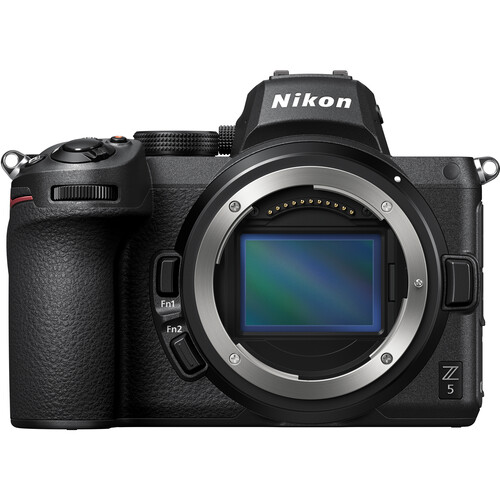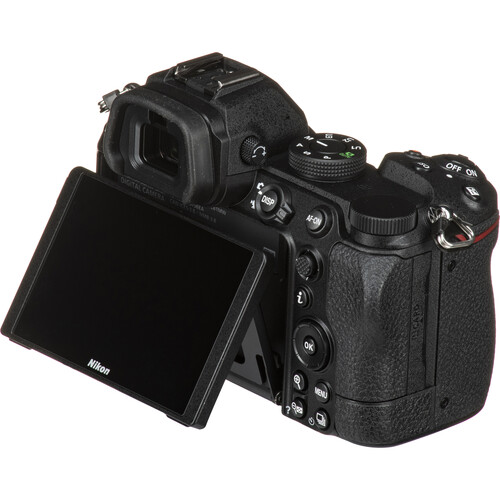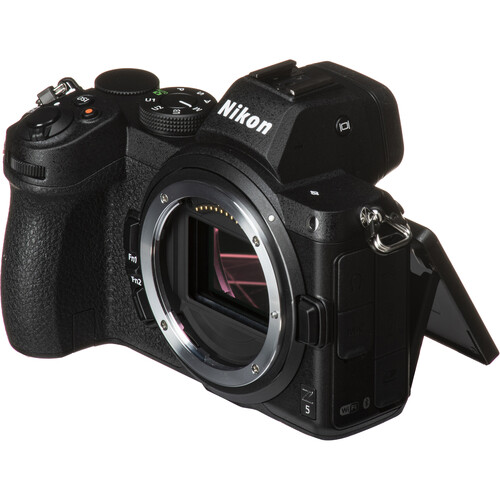If you’ve been curious about stepping into the world of full-frame mirrorless photography without breaking the bank, the Nikon Z5 is probably on your radar. Since its release in 2020, it has become one of Nikon’s most approachable options for photographers who want the benefits of a full-frame sensor at an entry-level price. And now, in 2025, the Nikon Z5 is still very much a camera worth talking about, especially as the Z system continues to grow and evolve.
The Nikon Z5 is often described as a “gateway camera” into Nikon’s mirrorless ecosystem. But that description doesn’t do it full justice. While it is budget-friendly, the camera delivers an experience that feels anything but entry-level in many areas. Its robust build, reliable in-body image stabilization, and image quality that holds up against much newer models make it a strong contender in the used market today. For those who care about value, the Nikon Z5 is one of the most compelling cameras you can buy in 2025.
In this updated review, I’ll break down everything from build quality and ergonomics to autofocus, video performance, and overall value in today’s camera landscape that will help you decide whether the Nikon Z5 still makes sense for your photography needs.
Table of Contents
- Nikon Z5 Design and Build Quality
- Sensor Performance and Image Quality
- Autofocus and Shooting Speed
- Nikon Z5 Video Capabilities
- Handling and Usability
- Nikon Z5 Lenses and System Compatibility
- Value of the Nikon Z5 in 2025
- Final Verdict
- FAQ
Nikon Z5 Design and Build Quality

The Nikon Z5 feels reassuring in the hands. Despite being Nikon’s most affordable full-frame mirrorless camera, it doesn’t compromise on construction. Built with a magnesium alloy frame and weather sealing, it’s durable enough for travel and outdoor shooting. In practical use, you can take the Nikon Z5 into dusty, damp, and cold conditions without worry.
Ergonomics are one of Nikon’s strongest selling points, and the Nikon Z5 continues that tradition. The grip is deep and comfortable, making it easy to use with both small prime lenses and larger zooms. The button layout feels intuitive, particularly if you’ve ever used a Nikon DSLR. For beginners, it offers a short learning curve, while seasoned Nikon shooters will feel immediately at home.
The electronic viewfinder (EVF) is a bright 3.69-million-dot display, which still holds up very well in 2025. Composing shots feels natural, and the refresh rate makes it easy to follow moving subjects. The rear LCD is a tilting touchscreen—useful for low angles, though some may wish for a fully articulating screen like you find on newer cameras. Still, for photography-first shooters, the screen is more than adequate.
Sensor Performance and Image Quality

Photo by Nicole Wreyford on Unsplash (license)
At the heart of the Nikon Z5 is a 24.3MP full-frame CMOS sensor, and it continues to deliver excellent image quality even in 2025. While newer cameras may boast higher resolutions, the balance here between file size and detail is ideal for most photographers. Prints look fantastic up to large sizes, and the files hold up very well under post-processing.
Low-light performance is strong, thanks to solid ISO handling. You can comfortably push the Nikon Z5 to ISO 6400 or even 12,800 with minimal noise, which makes it suitable for events, indoor photography, and night street shooting. Personally, I’ve been impressed with how forgiving the RAW files are when pulling detail out of shadows or taming highlights in challenging lighting.
The dynamic range gives you plenty of room to recover information, which is especially useful for landscape and travel photographers. Colors are rich yet natural, staying true to Nikon’s reputation for beautiful color science. JPEG shooters will appreciate the straight-out-of-camera look, while RAW shooters will have the flexibility to fine-tune results in editing.
Autofocus and Shooting Speed

The Nikon Z5 uses a 273-point hybrid autofocus system that covers most of the frame. It’s not as advanced as the newer Z6 II or Z8, but in everyday use it’s more than capable. Eye-detection autofocus for humans and animals works well, locking focus with reliability in portrait and candid shooting situations.
Where the Nikon Z5 does show its age is in fast-moving subjects. With a maximum burst rate of 4.5 frames per second, it’s not built for sports or wildlife photography. If you’re primarily shooting family, travel, or landscapes, this isn’t an issue. But if action photography is your focus, you might consider stepping up to the Z6 series or beyond.
That said, in casual action scenarios, the autofocus holds up. You will likely find that photographing kids running, pets playing, and even street scenes can be successful. The continuous autofocus tracking is reasonably sticky, though not on par with Sony’s or Canon’s newer systems. For most hobbyists, though, it gets the job done.
Nikon Z5 Video Capabilities
On the video front, the Nikon Z5 is competent but not cutting-edge. It shoots 4K, but with a 1.7x crop. As Ralph Mayhew Photography discusses above, that crop can feel restrictive, especially if you’re working with wide-angle lenses. For vloggers and content creators who need full-frame 4K, this might be a dealbreaker. However, for casual clips, family videos, or supplementary content, the quality is clean and detailed.
1080p recording is available without crop, and the footage is solid for everyday use. The in-body image stabilization helps smooth handheld shots, which is particularly handy when traveling light without a gimbal. Rolling shutter performance is decent, though you’ll notice it with fast pans.
For hybrid shooters who lean more toward photography but want some video capability, the Nikon Z5 remains a practical option. For those who prioritize video production, Nikon’s newer Z cameras—or even competitor systems—may be a better fit.
Handling and Usability

One of the reasons I’ve always liked the Nikon Z5 is its handling. Nikon’s menu system is straightforward, avoiding the clutter and confusion you sometimes see with other brands. Assignable buttons and customizable controls make it easy to tailor the camera to your style of shooting.
The Nikon Z5 also includes dual UHS-II SD card slots, which is rare for a camera at this price point. That gives you flexibility for backup, overflow, or separating RAW and JPEG files. It’s a feature that adds real value for professional use, even in an entry-level full-frame body.
Battery life is respectable, and the USB-C charging option is a huge convenience. On long road trips and camping outings, I’ve kept it topped up with a portable power bank. The five-axis in-body stabilization is another highlight, giving you the confidence to shoot handheld in lower light without relying on a tripod as often.
Nikon Z5 Lenses and System Compatibility

Photo by Gautam Singh on Unsplash (license)
When the Nikon Z5 launched, one of the main criticisms was the limited Z-mount lens lineup. Fast forward to 2025, and that’s no longer the case. Nikon’s Z system now boasts an impressive range of lenses, from affordable kit zooms to professional primes and exotic telephotos. Third-party support has also expanded, giving photographers even more choice.
If you’re upgrading from a Nikon DSLR, the FTZ adapter (shown above) allows you to use your existing F-mount glass. Many photographers have done this with classic Nikon lenses, and the performance is excellent. Autofocus is reliable, and image quality holds up beautifully. This makes the Nikon Z5 a natural step forward for longtime Nikon shooters.
For those starting fresh, there are plenty of budget-friendly Z-mount lenses that pair nicely with the Z5. The 40mm f/2, 28mm f/2.8, and 24-50mm kit zoom are compact and lightweight, matching the camera’s entry-level ethos while still delivering strong performance.
Value of the Nikon Z5 in 2025

In 2025, the Nikon Z5 continues to shine when it comes to value. On the new market, it remains competitively priced. But the real deals are in the used market, where you can often find the Nikon Z5 for a fraction of what it cost at launch. Compared to alternatives like the Canon EOS R8, Sony a7C II, or even Nikon’s own Z6 III, the Z5 offers incredible bang for your buck if you prioritize still photography over advanced video features.

Personally, my go-to platform for buying and selling used gear is MPB. They have a massive inventory of cameras and lenses, and every piece of gear is carefully inspected and graded by their professional technicians. Most items come with a six-month warranty, and they offer a seven-day return window in case something isn’t quite what you expected. In all the years I’ve used MPB, I’ve never once had to return an item—everything has been exactly as described. For anyone considering the Nikon Z5 in 2025, MPB is a fantastic place to pick one up.
Ultimately, the Nikon Z5 is best suited for beginners stepping into full-frame photography, travel shooters looking for a lightweight companion, and hobbyists who want high-quality images without stretching the budget. It’s less ideal for action shooters or those who need advanced video features. But for its price, it’s still one of the smartest buys in the mirrorless market.
Final Verdict

Photo by Gautam Singh on Unsplash (license)
The Nikon Z5 may be a few years old, but in 2025 it remains an excellent option for photographers who want a capable full-frame camera at an accessible price. It combines solid build quality, excellent image performance, and useful features like IBIS and dual card slots—things you don’t always see in this price category.
Its limitations are clear: the cropped 4K video, modest burst rate, and slightly older autofocus system mean it’s not the best choice for every type of shooter. But for most photographers, particularly those focused on stills, it delivers more than enough to justify its place in your kit.
If you’re entering the full-frame world for the first time, the Nikon Z5 deserves serious consideration. And with the used market offering incredible deals, there’s arguably never been a better time to add one to your bag.
FAQ
Is the Nikon Z5 still worth buying in 2025?
Yes, the Nikon Z5 is still worth buying in 2025 if your focus is photography. It offers full-frame image quality, in-body stabilization, and a durable build at a price that’s hard to beat.
Does the Nikon Z5 shoot 4K video?
It does, but with a 1.7x crop. For casual video use it’s fine, but creators who need uncropped 4K may prefer the Z6 II or newer Nikon models.
What type of photographer is the Nikon Z5 best for?
The Nikon Z5 is ideal for beginners moving into full-frame, travel shooters, and hobbyists who want excellent image quality without overspending. It’s less suited for sports or professional video work.
What lenses work with the Nikon Z5?
The Nikon Z5 uses Z-mount lenses, and the lineup in 2025 is extensive. You can also use older Nikon F-mount lenses with the FTZ adapter, which works very well.
Where is the best place to buy a Nikon Z5 in 2025?
For new gear, most camera retailers stock the Z5. For used gear, MPB is my personal recommendation thanks to their wide inventory, careful inspections, warranties, and excellent customer service.
Heads up: Clicking on our affiliate links and exploring our sponsored content helps us at no extra cost to you, and we only recommend gear we’re absolutely crazy about!
Learn More:
Hero photo by Gautam Singh on Unsplash (license)


Instagram URL Shortener
[…]Wonderful story, reckoned we could combine a number of unrelated data, nonetheless really worth taking a look, whoa did 1 learn about Mid East has got additional problerms at the same time […]